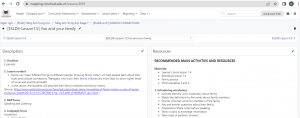Plan learning activities
Learning activities should meet the following criteria:
- being directly related to the learning objectives
- being predicated on students’ learning profile (ability, interests, preferences, needs, etc.)
When considering what learning activities to organize in a lesson, teachers can refer to the curriculum mapping platform where a list of recommended activities is presented. It should be noted that these activities are optional, not mandatory. Teachers can make their own choice in whether to adopt these suggested ideas or design some of their own that better suit their students’ needs.
A variety of activities can be employed to engage students. Based on the teaching & learning goals, class profile and classroom environment features, a careful selection of activities is required to ensure a high impact learning experience delivery to students. Below is a table of different types of activities and their descriptions.
| Activity Type | Learning Activity | Description |
| Interaction with content
|
Drill and practice | Problem/task is presented to students where they are asked to provide the answer; may be timed or untimed |
| Lecture | Convey concepts verbally, often with visual aids (e.g. presentation slides) | |
| Quiz | Exercise to assess the level of student understanding and questions can take many forms, e.g. multiple-choice, short-structured, essay etc. | |
| Student presentation | Oral report where students share their research on a topic and take on a position and/or role | |
| Interaction with digital content
|
Game | Goal-oriented exercise that encourages collaboration and/or competition within a controlled virtual environment |
| Simulation | Replica or representation of a real-world phenomenon that enables relationships, contexts, and concepts to be studied | |
| Interaction with others
|
Debate | Verbal activity in which two or more differing viewpoints on a subject are presented and argued |
| Discussion | Formal/informal conversation on a given topic/question where the instructor facilitates student sharing of responses to the questions, and building upon those responses | |
| Feedback | Information provided by the instructor and/or peer(s) regarding aspects of one’s performance or understanding | |
| Guest Speaker | Feelings, thoughts, ideas and experiences specific to a given topic are shared by an invited presenter | |
| Problem solving and Critical thinking
|
Case Study | Detailed story (true or fictional) that students analyze in detail to identify the underlying principles, practices, or lessons it contains |
| Concept Mapping | Graphical representation of related information in which common or shared concepts are linked together | |
| Real-world projects | Planned set of interrelated tasks to be executed over a fixed period and within certain cost and other limitations, either individually or collaboratively | |
| Reflection
|
Reflection journal | Written records of students’ intellectual and emotional reactions to a given topic on a regular basis (e.g. weekly after each lesson) |
(Source: https://cte.smu.edu.sg/approach-teaching/integrated-design/lesson-planning)
